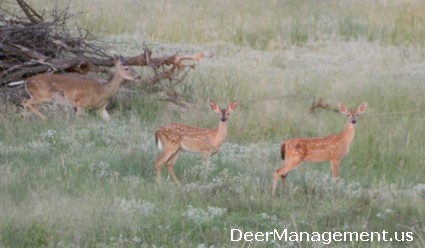One of the biggest factors that affects deer hunting each year is habitat conditions. Successful deer management means adapting to what you see on the ground. This is a simple concept to grasp, but there are several factors that play into what is actually happening on the ground. The biggest factor that impacts the deer herd as a whole is overall nutrition of each individual animal.
If each deer on your property is fat and happy then the population is doing great. If many of the deer are lacking adequate nutrition then things are tough for the herd and you can fully expect less than average body size, poor fawn crops and weak antler growth by bucks by age class. Total herd size and habitat conditions are the major components of food intake by animals as well as food supply.
 Both deer numbers and habitat conditions, which are determined by rainfall, change annually. New fawns hit the ground each year. Good survival will mean more deer hunting opportunity, shooting more deer in the fall. Poor survival means shooting fewer or maybe even no deer. The quality of the habitat and the condition of the habitat can further elevate or decrease the number of fawns.
Both deer numbers and habitat conditions, which are determined by rainfall, change annually. New fawns hit the ground each year. Good survival will mean more deer hunting opportunity, shooting more deer in the fall. Poor survival means shooting fewer or maybe even no deer. The quality of the habitat and the condition of the habitat can further elevate or decrease the number of fawns.
For example, what may be otherwise good habitat may be plagued by drought, dragging down fawn survival during that year. What is otherwise marginal deer habitat can produce a good numbers of fawns during great rainfall years. The problem is that most years are not great rainfall years. Additionally, poor habitat can produce decent fawn crops every year if the deer population is kept low, meaning for food for every deer out there.
Central Texas Deer Hunting
Now let’s talk about my part of the word, the central portion of Texas. This year deer surveys have revealed lots of fawns in the area. Surveys on the ranches where I work have wrapped up and it appears the average fawn survival rate this year is around 70%. More deer added means increased doe harvest this fall to make room for the new batch.
Unfortunately, the habitat, primarily browse plants, are still recovering from the ongoing drought that peaked in 2011 and 2012, so there is still a real need to keep your deer herd at a moderate level and under control to allow the quality forage plants a chance to rest and recover.
The rains received during 2013 in Central Texas have helped a bunch and the deer are in good condition, but things can and will change in a hurry. Deer management means adapting to what the habitat and the deer herd are doing. It’s one of the ventures where the work is never, ever done. It’s always a work in progress, but that is what makes whitetail management and hunting so darn fun.